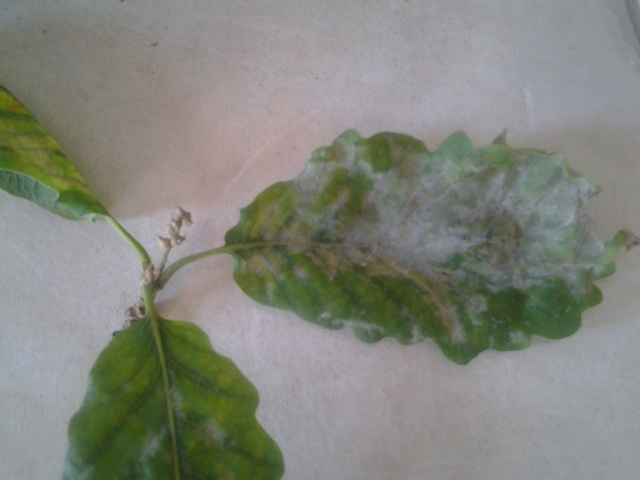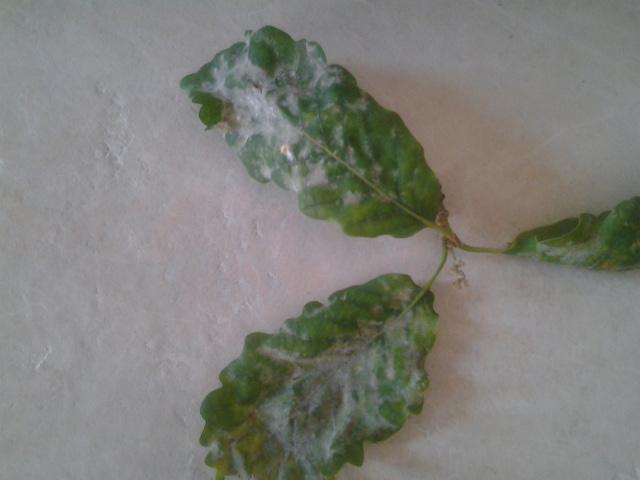Question Oak tree disease2
Oak tree disease2
 Oak Tree disease
Oak Tree disease
QUESTION: Good day Jim, We recently noticed that the leaves from one of our oak tree start falling down even though they are still young and green. These leaves have a grey like mouldy substance on them (see attached pics.) There are 8 trees in total and we are concerned this might spread to others.
What can we use?
ANSWER: Sounds like powdery mildew.
Powdery mildews, as the name implies, often appear as a superficial white or gray powdery growth of fungus over the surface of leaves, stems, flowers, or fruit of affected plants. These patches may enlarge until they cover the entire leaf on one or both sides. Young foliage and shoots may be particularly susceptible. Leaf curling and twisting may be noted before the fungus is noticed. Severe powdery mildew infection will result in yellowed leaves, dried and brown leaves, and disfigured shoots and flowers. Although it usually is not a fatal disease, powdery mildew may hasten plant defoliation and fall dormancy, and the infected plant may become extremely unsightly.
To control this fungus spray the foliage with a fungicide. I am not at all familiar with your country or the availability of fungicides but here is the list we use in the USA.
Fungicides must be used to achieve acceptable control. For best results with fungicides, spray programs must begin as soon as mildews are detected. Spray on a regular schedule, more often during cool, damp weather. Use a good spreader-sticker with the fungicides. Be sure and cover both surfaces of all leaves with the spray. Fungicides generally recommended for powdery mildew control include: Triadimefon (Bayleton, Strike); Triforine (Funginex), Thiophanate-methyl (Cleary's 3336, Domain) and Propiconazole (Banner).
Baking soda has been used to control this disease on some plants. Baking Soda Spray: for anthracnose, early tomato blight, leaf blight and spots, powdery mildew, and as a general fungicide Sodium bicarbonate commonly known as baking soda has been found to posses fungicidal properties. It is recommended for plants that already have powdery mildew to hose down all the infected leaves prior to treatment. This helps to dislodge as many of the spores as possibly to help you get better results. Use as a prevention or as treatment at first signs of any of the diseases.
To make: Mix 1 tablespoon baking soda, 2 1/2 tablespoons vegetable oil with one gallon of water. Shake this up very thoroughly. To this mix add 1/2 teaspoon of liquid soap and spray. Be sure to agitate your sprayer while you work to keep the ingredients from separating. Cover upper and lower leaf surfaces. Repeat every 5-7 days as needed.
---------- FOLLOW-UP ----------
QUESTION: As I indicated this will be a cumbersome process to spray trees that are 3 floors building high. Is there any alternative to administer the solution into the roots?
AnswerOK I assumed that the trees were small-my mistake. All the fungicide treatments are really just a chemical coating on the leaves so the fungi can not get a hole. There are no soil applied fungicides that will work on Powdery Mildew. But the good news is the Powdery Mildew will not kill the tree. It may make it look bad and cause the tree to drop it leaves sooner than normal. On large trees such as oak, powdery mildew typically appears late in the season. Because of this, the disease does not cause significant harm to the plant, as the leaves are almost done their job of making food for the year and will drop soon. No management is typically recommended on large trees.
Powdery mildew thrives in humid conditions but does not do well if leaves are wet from frequent rain or irrigation. Favorable conditions for powdery mildew commonly occur when cool nighttime temperatures are followed by warm day temperatures.
Here are a few things that may help manage the disease.
Prune the tree or shrub to increase light penetration and improve air circulation throughout the canopy. But I would wait until after next year to see IF the fungi effects the tree again. Diseases come in cycles and depending on the weather it mat not be a problem each tear. at the end of the growing season, remove and destroy any infected plant debris as this can serve as a source of spores for the next growing season.
Do not fertilize trees and shrubs suffering from powdery mildew infections, unless it is recommended by a soil test to correct a nutrient deficiency
I would rake the leaves that fall and destroy them to reduce the amount of spores in the area.
Again sorry about the confusion somehow I thought small trees. I hope this helps.







